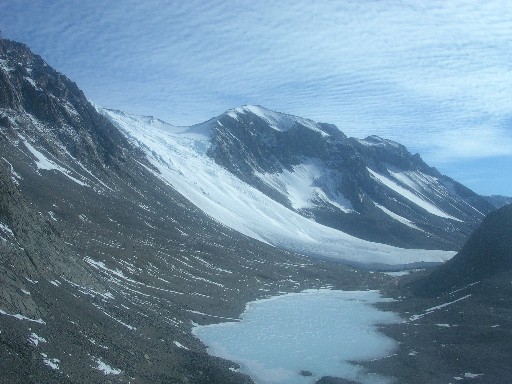 |
|
|
Home|Glossary|Links|Journal|Maps
At the Ice’s Edge Kirk, Ray, and I had just finished measuring the flow at a site on the Onyx River, and we were trying to figure out what to do next. Our helicopter flight yesterday had been canceled because of bad weather in McMurdo. Today, Sunday, was the one rest day of the McMurdo workweek and a no fly day. Our tasks at our current location were pretty much done. We discussed the various options. We could hike upstream towards Lake Brownworth. We could hike up a ridge. We could hike downstream towards we weren’t sure what. Then an alternative in the form of a blond stranger showed up. “How’d you like to do a bit of ice climbing?” he asked. “We’ve got all the gear.” Kirk, Ray, and I turned to look at each other. It seemed perfect. Too perfect.
Sometimes Antarctica can feel like a bit of an illusion. With 24 hours of sunlight during summer, it is difficult to distinguish between day and night and between one day and the next. Trying to figure out north, south, east, and west at the bottom of the earth where the geographic and magnetic poles can no longer be lumped together can challenge even the most directionally adept people. And with the clearest of air, distances are incredibly difficult to judge. That peak just up ahead can actually be miles away. Fortunately for us, and for the stranger whom we found out was named Lawrence, his teammates Shelley and Gretchen had shown up the day before giving credence to his story of being a glacier guide and part of a New Zealand glaciology team. After further consideration, we decided that Lawrence seemed real enough and proceeded to follow him to the Lower Wright Glacier. Glaciers are masses of ice and usually some snow that are large enough and thick enough to flow – albeit since they typically move only a few feet per year, it’s pretty slow going. Glaciers form when snow persists and accumulates from year to year. The new layers of snow bury and compress the older layers causing them to become denser. With time the snow crystals eventually compress into glacial ice. At about 18 meters of thickness the ice is heavy enough to deform and move. Glaciers currently cover about 10% of the world’s land area and contain 75% of the world’s freshwater. Although they are most prevalent in polar regions like Antarctica and Greenland, they can be found on nearly every continent. Ray and Kirk have both done work on glaciers in Wyoming in the U.S., and Lawrence does most of his guiding on glaciers in New Zealand. This was his first time in Antarctica. It was Gretchen’s first time as well. Shelley was the veteran of the group, this being her fourth season. In her spare time, she had managed to read all six Harry Potter books. In her non-spare time, she was working on an energy balance of the Lower Wright, a piedmont glacier, and on previous occasions she had done some work on alpine glaciers in the valleys as well. |
